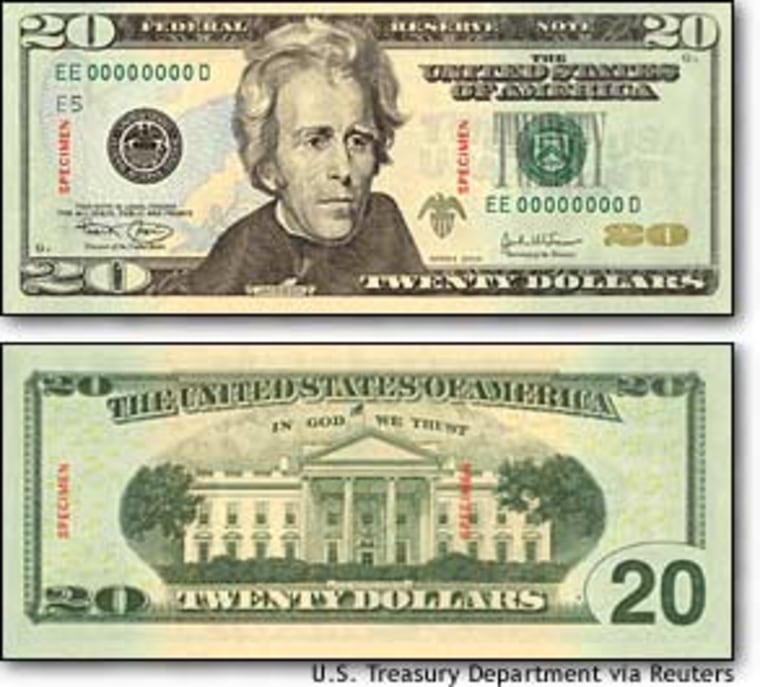The revamped U.S. $20 bill, with its faint tinge of peach color in the background, began making its way into bank vaults and consumers’ pockets Thursday, accompanied by a $33 million advertising campaign to alert the public to the change.
The introduction into circulation of the new bill, a makeover of a bill previously redesigned in 1998, is meant to thwart increasingly high-tech counterfeiters. And even though it was not meant to be a security measure, the most prominent new feature of the bills, the addition of subtle peach, green and blue background colors, is expected to make counterfeiting harder.
“This is the most secure note the U.S. government has ever produced,” Fed governor Mark Olson said last month.
The $20 is the most counterfeited note in the United States. The $100 is the most popular with counterfeiters outside the country.
The new $20, whose design was unveiled in May, features an image of Andrew Jackson, the seventh president. On both the front and back of the new twenties, moving from left to right, there’s a faint wash of green tint, then peach down the middle, then green again in what had been the neutral-colored background of the old notes.
The image of Jackson appears slightly bigger because more of his neck and shoulders are in view and the border around his oval portrait has been removed. But his head is the same size on the new bill.
The new design also includes a faint blue eagle in the background on the front of the bill to the left of Jackson’s image and a metallic green eagle and shield to the right of Jackson. Also on the front, hovering near the eagle and shield, are the words ‘Twenty USA’ printed in a faint blue.
On the back, the White House still dominates on the new $20, but a border once around the image is gone. Also, tiny number 20s are printed on the back in yellow, floating in the background.
The Fed, which had been building up its inventory of the new bills for four months, planned to have about 915 million of the individual notes ready for distribution.
The new notes will begin showing up in cash registers, ATM machines and wallets as soon as this weekend. Remote areas and overseas locations may see them a bit later.
The changeover is being accompanied by a public education campaign to acquaint consumers with the currency and to reassure them that the old notes will remain valid tender. The Treasury Department’s Web site includes an interactive tutorial on the new bill, and an overview of its ad campaign, a money map that tracks where the new bills are showing up and games for kids, including an interactive feature that lets you design your own new bill and send it to your friends.
Global media events
With two-thirds of U.S. currency circulating outside U.S. borders, more than 200 media events are also planned globally, according to Marsha Reidhill, assistant director for cash and fiscal agency for the Fed.
Federal banking officials in New Orleans, for example, planned to hand out the new bill in an historic cafe in what will be the first commercial transaction using the bill in the New Orleans area.
Officials with the New Orleans Branch of the Federal Reserve were set to use the new paper money at Cafe Du Monde in Jackson Square.
The average life span of a $20 bill is about two years. That means it may take some time for the new bills to become commonplace, officials said.
New designs for $50 and $100 bills are expected in 2004 and 2005, respectively. The government is considering whether to change the $5 and $10 notes. There are no plans to alter the $1 or the obscure $2 bill, which are not worth counterfeiting.
Colors will vary by denomination, something that should make it easier for people to distinguish notes from one another, officials say.
U.S. paper money has not had background color since 1905, when the $20 note was tinted gold.
The money is being sent to Federal Reserve banks in Dallas, San Francisco and Kansas City, Mo., from the Bureau of Engraving and Printing’s Western Currency Facility in Fort Worth, Texas.
The Fort Worth plant started making the new $20 bills in June, and printing presses produce 10,000 32-note sheets per hour. Each bill takes about four weeks to finish, said plant manager Charlene E. Williams.
The Western Currency Facility produces 54 percent of the nation’s currency — about 18 million bills a day — and the rest is made at the Bureau of Engraving and Printing plant in Washington, D.C.
The 600,000-square-foot plant opened in northwest Fort Worth in 1991, employs about 700 people and makes $1, $2, $5, $10 and $20 bills. An expansion project, adding 150,000 square feet for production and truck loading areas and a visitors center, is to be finished next year.
The Associated Press and Reuters contributed to this report.
